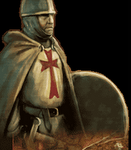Further to my post outlining some Great British Military Actions, most since forgotten by all but a few and certainly NOT taught in our multi-culti schools (perish the thought of the British people being taught anything about their own countrys history! - these days its all Negroes and Nazis as my daughter tells me politely).
This post is a brief overview of one of these heroic (in the TRUE sense of the word and not as applied to any fool who can kick a ball!) actions dating from the First World War (1914 - 1918).
On 26th August 1914 General Alexander Von Kluck with the German First Army almost succeeded in encircling the British (II Corps) , after our French allies withdrew under heavy German pressure. Tough fighting ensued and II Corps were able to break free and resume the retreat to the Marne. Von Kluck was intent on destroying the BEF (British Expeditionary Force) and caught up with the British rearguards on 1st September in several towns and villages including Nery.
This last engagement whilst small in scale was to have far reaching consequences for the German First Army. Nery lies about 45 miles northeast of Paris. "L" Battery Royal Horse Artillery (RHA), The Queens Bays, 5th Dragoon Guards and the 11th Hussars were picketed down for the night. German cavalry were observed in the early hours by an 11th Hussars patrol and within minutes the village was under heavy weapons fire from German advance elements, between 600 and 800 yards away, consisting of artillery, rifle and machinegun fire.
The British units could not move under such concentrated fire and were obliged to remain at their posts until help arrived. The enemy were Von Klucks 4th cavalry, screening the right flank of the german advance. Just prior to the german arrival "L" Battery had hitched up in preparation of an early morning move-out and the german artillery batteries immediately targetted four of their twelve guns onto the "L" battery positions. Under a firestorm of shells and small arms fire from the german artillery and dismounted cavalry squadrons, many of "L" batterys men and horses were decimated in minutes. Many of the British gunners were killed before they could respond and the situation was desperate (remember these boys were the rearguard protecting the allied retreat).
With a shout of "Come on! Whos for the guns?", Captain E.K.Bradbury along with three subalterns and the few remaining gunners still on their feet, managed to unlimber three guns and swing them round to face the enemy. Bradbury and Sgt D.Nelson manned one, Lieutenants Cambell and Mundy the second and Lieutenant Gifford and some gunners manned the third. Every round had to fetched from over twenty yards of exposed ground, but there was no shortage of volunteers. Initially "L" batterys three guns verus the german four seemed reasonable odds, but Campbells gun was hit and wrecked and Campbell killed. Two subalterns ran to help Bradbury. Giffords gun received a direct hit, killing Gifford and most of the gunners and badly wounding the other crew of the third gun. Bradbury now face odds of four to one and he was supplied with ammunition by Gunner Darbyshire and Driver Osbourn. They must have inflicted some damage as the eight remaining german guns switched their fire on to the lone gun from "L" battery, as well as the initial four.
For an hour the lone British 13 pounder fired on, one versus twelve, in the midst of a death filled bombardment from the german gunners. One by one the ammunition carriers were hit and the rate of fire from the men at the muzzle became sporadic. By 07.15 AM only Bradbury and Sgt. Nelson (who was badly wounded) remained at the gun. Battery Sergeant-Major Dorrell ran under fire to join them. Bradbury left the gun to go for more ammunition and was mortally wounded. Nelson and Dorrell fired the last few rounds available and the gun fell silent. For a moment it looked like it was all for nothing. However the germans had been deprived of their local artillery cover (which had been engaged with "L" battery) and the British had launched a local counter-attack with two squadrons of the 5th Dragoon Guards, followed by "I" Battery RHA and the 4th British Cavalry Brigade along with infantry units. The Germans were routed, leaving eight of their guns abandoned.
British casualties from this action amounted to 135 officers and men, of which 5 officers and 49 other ranks were from "L" Battery. Captain Bradbury received the Victoria Cross (posthumously) as did Nelson and Dorrell. The battery won the Honour Title "Nery",and one of its guns is on display at the Imperial war Museum in London.
Arthur Wellesley (1769-1852) - the Duke of Wellington
"The scum of the earth. The mere scum of the earth".
(Describing his own army in the nineteenth century)
Subscribe to:
Post Comments (Atom)



1 comment:
I am trying to get in touch with you. Kindly write to me, at economics@bnp.org.uk.
Best Regards,
Alan Goodacre
Post a Comment